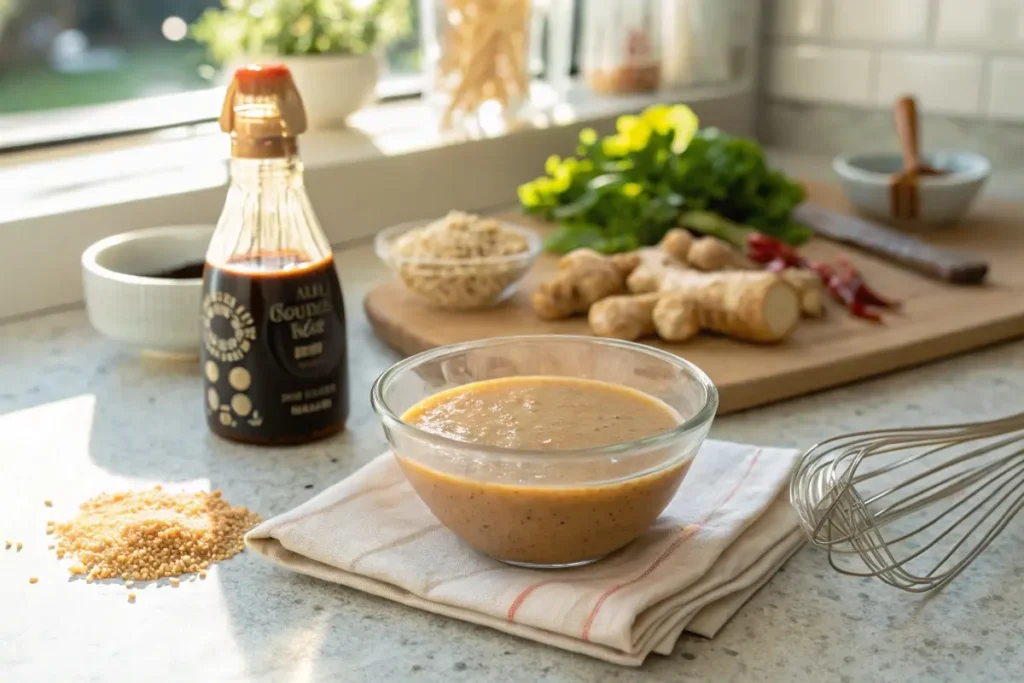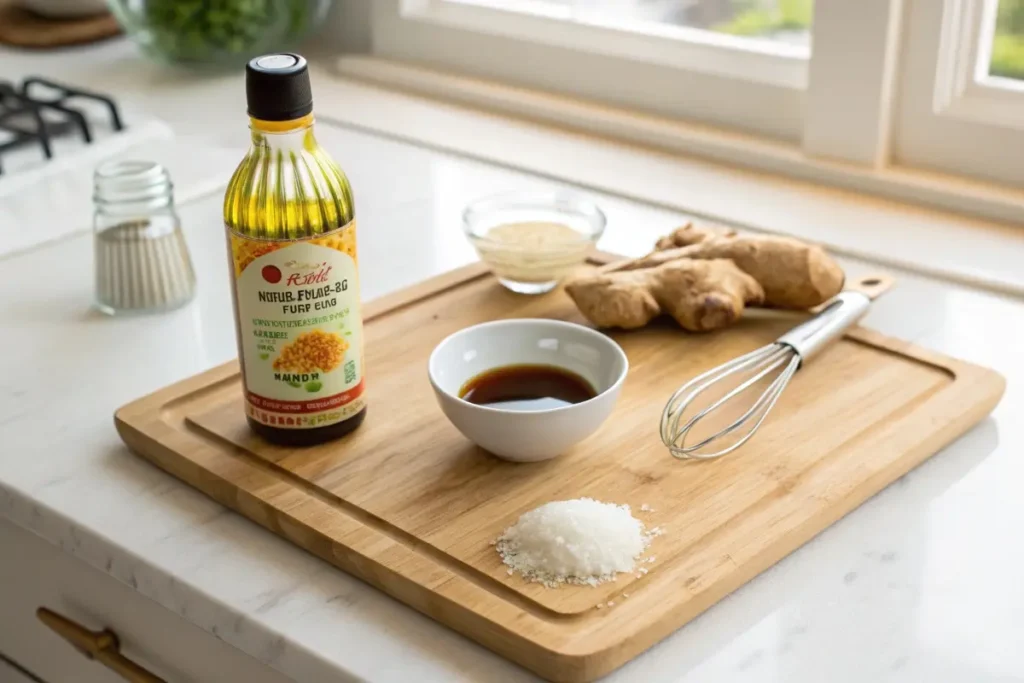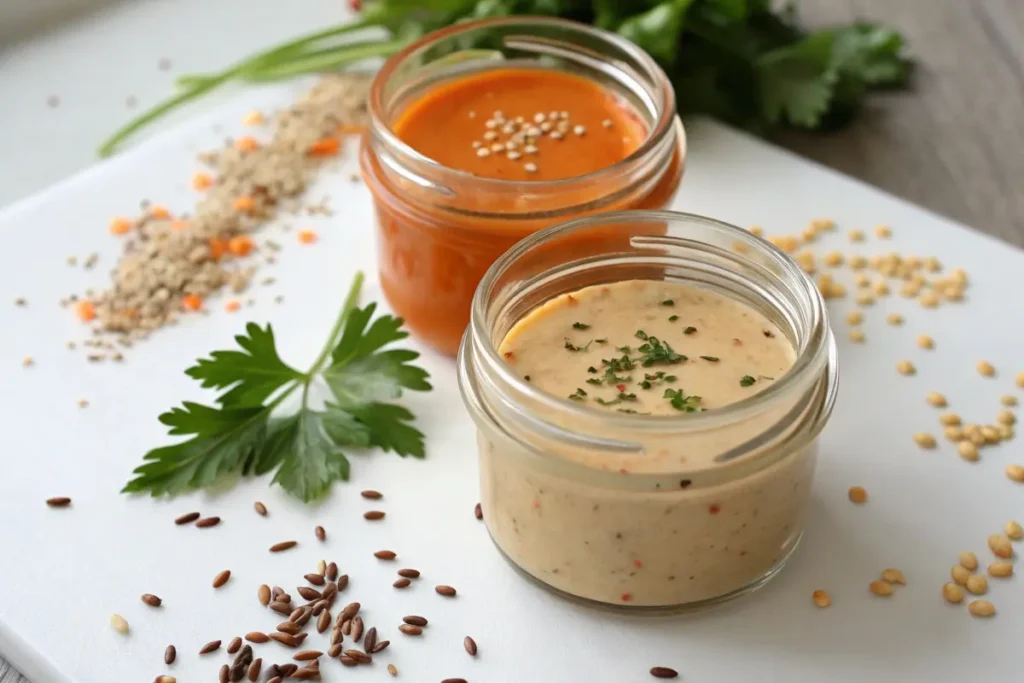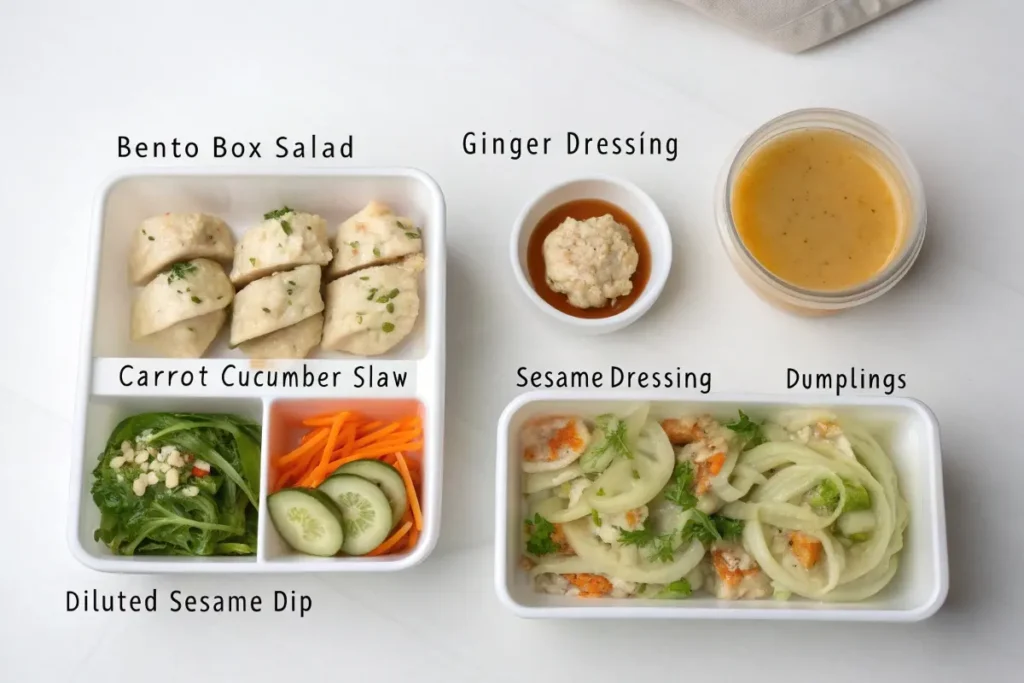If you’ve ever visited a hibachi grill or a Japanese steakhouse, you’ve likely encountered that tangy, refreshing japanese salad dressing recipe—often a ginger salad dressing that elevates humble greens into a memorable starter. Within seconds of tasting it, you notice its bright acidity and savory backbone, hinting at ingredients like fresh ginger, soy sauce, and perhaps a hint of miso or sesame. You might ask, What does Makoto ginger dressing taste like? or wonder how many calories are in Japanese ginger salad dressing.
This article will walk you through everything you need to know: from fundamental recipes and health insights to history, tips for variations, and answers to commonly asked questions like What is the basic salad dressing formula? By the end, you’ll have all the tools to recreate this hibachi ginger dressing—and more—right in your own kitchen.
For additional inspiration, you might enjoy exploring our Japanese Cucumber Salad Recipe if you appreciate bright, crunchy salads. Now, let’s dive into the world of Japanese-style salad dressings and the multiple ways to incorporate them into your meals.

Pro Tip: If you want to make authentic Japanese dressings at home, a few pantry staples are essential. These are my go-to ingredients (all available on Amazon):
What Makes Japanese Salad Dressings Unique
At their core, japanese salad dressing recipes stand out for their clean, bright flavors. Unlike thick Western dressings that can be heavy on cream or oil, Japanese versions often rely on vinegars, soy sauce, ginger, garlic, or miso to create a layered yet light taste profile.
The Balancing Act: Sweet, Sour, Salty, and Umami
A recipe for ginger dressing often includes:
- Rice vinegar (sour)
- Soy sauce (salty + umami)
- Sugar or mirin (sweet)
- Ginger (aromatic, slightly spicy)
This balancing act forms the foundation of many Japanese dressings. By carefully adjusting these elements, you can achieve a sesame cucumber salad or a mild hibachi salad dressing that complements rather than overpowers the greens.
Texture and Freshness
Because the base leans more watery than creamy, Japanese dressings coat vegetables lightly. Hibachi ginger dressing typically includes pureed ginger and sometimes grated carrots or onions, creating a texture that’s slightly chunky, fresh, and reminiscent of homemade.
Variety of Uses
While typically poured over lettuce, cucumbers, or mixed greens, japanese salad dressing recipe can serve as:
- A marinade for grilled meats, giving a tangy, subtly sweet depth.
- A dipping sauce for veggies or dumplings.
- A drizzle over grain bowls, especially if you’re looking to enliven plain rice or quinoa.
Health Benefits
Many diners wonder, How many calories are in Japanese ginger salad dressing? The answer depends on the ratio of sweeteners (sugar, honey, or mirin) to oil. Nonetheless, most Japanese dressings are lower in fat compared to cream-based options like ranch or Caesar. Plus, ginger offers anti-inflammatory properties, and vinegar can aid digestion.
Four Types of Salad Dressing Basics
Asked What are the four types of salad dressing? you typically see:
- Vinaigrettes: Oil + vinegar (or acid), often with added herbs or spices.
- Creamy Dressings: Typically use dairy (e.g., ranch) or mayonnaise.
- Cooked Dressings: Thicker, with a cooked base of flour or eggs (like some Caesar variations).
- Japanese/Asian Vinaigrettes: A subcategory where elements like soy sauce, sesame oil, or ginger become the star.
Japanese dressings generally fall under the vinaigrette category but with an East Asian twist that emphasizes umami and gentle sweetness.
For more vegetable-focused recipes that benefit from these dressings, explore our Vegetables Japanese Recipe page, where you can pair stir-fried or steamed veggies with a drizzle of ginger or sesame dressing. Whether it’s a crisp lettuce salad or lightly blanched vegetables, the distinct sweet-tangy-umami flavor profile makes Japanese dressings incredibly versatile and widely beloved.

Fundamental Japanese Salad Dressing Recipes
While the japanese salad dressing recipe world is vast, there are a few core formulas that frequently appear on restaurant menus and in home kitchens. Below, we’ll explore two main dressings: ginger-based and sesame-based, each easily adaptable to personal tastes.
Kitchen Tip: Prepping ginger and sesame dressing is much easier with the right tools. Here are a few that save time in the kitchen:
- Japanese Ginger Grater (ceramic or stainless steel)
- Mini Food Processor / Blender
- Mortar & Pestle for sesame seeds
1. Classic Japanese Ginger Dressing
Why It’s Popular: Known as hibachi ginger dressing when served in steakhouses, this version typically features grated fresh ginger, onions, and carrots, giving it a vibrant orange hue.
Ingredients (Makes ~1 cup):
- 1/4 cup grated carrot
- 1 tablespoon grated fresh ginger
- 2 tablespoons minced onion
- 2 tablespoons rice vinegar
- 1 tablespoon soy sauce
- 2 tablespoons vegetable oil (like canola or grapeseed)
- 1 tablespoon sesame oil (optional for extra nuttiness)
- 1 tablespoon sugar (or honey to taste)
- Pinch of salt and pepper
Method:
- Blend or Whisk: Combine grated carrot, ginger, onion, vinegar, and soy sauce in a blender or food processor. If you prefer a chunkier texture, whisk by hand instead.
- Add Oil and Seasonings: Gradually pour in vegetable oil and sesame oil. Add sugar, salt, and pepper to taste.
- Adjust Consistency: If it’s too thick, add a tablespoon of water or more vinegar. Taste and balance sweetness or acidity as needed.
Taste Profile: Tangy, slightly sweet, with a gingery punch. Perfect drizzled over mixed greens or as a dipping sauce for grilled tofu.
2. Creamy Sesame Dressing (Goma Dressing)
Why It’s Loved: Also called goma dressing, this version harnesses the nutty aroma of toasted sesame seeds. Restaurants often serve it with spinach or lettuce salads.
Ingredients (Makes ~1 cup):
- 3 tablespoons toasted sesame seeds (plus more for garnish)
- 2 tablespoons rice vinegar
- 1 tablespoon soy sauce
- 1 tablespoon sugar (or mirin)
- 2 tablespoons mayonnaise (Japanese mayo if possible)
- 1 tablespoon sesame oil
- Pinch of salt
Authenticity Tip: For the richest flavor, use Japanese Kewpie mayo and high-quality toasted sesame seeds. You can easily find both online:
Method:
- Grind Seeds: Use a mortar and pestle or a spice grinder to lightly grind the toasted sesame seeds.
- Mix Wet Ingredients: In a small bowl, whisk vinegar, soy sauce, sugar, mayonnaise, and sesame oil.
- Combine: Stir in the ground sesame seeds, adjusting consistency with a little water if it’s too thick.
- Taste Test: Add salt if needed, or a drop more vinegar for extra tang.
Taste Profile: Rich, nutty, with a slight creaminess. Perfect for vegetable salads, grilled chicken, or as a drizzle over soba noodles.
Tips for Personalizing
- Adding Heat: A dash of chili flakes or a bit of wasabi can add heat to either dressing.
- Less Sugar: Substitute sugar with honey, maple syrup, or a pinch of stevia for fewer calories.
- Allergy Friendly: Use tamari or coconut aminos instead of soy sauce for gluten-free needs; skip sesame seeds if you have nut/seed allergies.
For additional sauces that can elevate your dishes, check out our Japanese Barbecue Sauce Recipes for ideas on basting grilled items or adding tang to stir-fries. With these two base recipes—ginger and sesame—you can cover a wide range of tastes and textures in your salad offerings.

History and Cultural Context
Though salad dressings aren’t the first thing that comes to mind when discussing traditional Japanese cuisine, the concept of dressing salads with vinegar-based sauces has existed for generations. Before the era of supermarkets and bottled dressings, Japanese cooks relied on basic pantry items—like miso, soy sauce, and vinegar—to flavor vegetables and seafood.
Traditional Inspiration
Historically, cold vegetable dishes and quick pickles (such as sunomono) showcased a tangy approach similar to what we see in modern japanese salad dressing recipe variations. Vinegar was invaluable for preservation in regions before refrigeration. Over time, as Western salads gained popularity in Japan, these existing methods of sour-sweet-umami seasoning naturally evolved into more standardized “dressings.”
Western Influence and Adaptation
In the early 20th century, as Japan embraced more Western-style dining, the idea of pouring a dedicated dressing over raw greens rose in popularity. Chefs and home cooks adapted Western vinaigrette techniques, infusing them with distinctly Japanese flavors: ginger, soy sauce, sesame, and miso. This fusion approach led to iconic creations like hibachi ginger dressing or ginger salad dressing reminiscent of Western “house dressings” but with an unmistakable Japanese twist.
The Health and Wellness Movement
In the latter half of the 20th century, as health consciousness grew globally, Japanese dressings garnered attention for their lighter, often oil-minimal composition. People found them to be a welcome alternative to cream-laden condiments. The success of bottled brands like Makoto is one example of how these dressings became mainstream. Curious consumers asked, What does Makoto ginger dressing taste like?—and discovered a fresh, piquant, and lightly sweet profile that quickly became a staple in many kitchens.
Contemporary Popularity
Today, you’ll find japanese ginger dressing recipe references on countless food blogs and in cooking classes. Restaurants worldwide top simple lettuce or cucumber salads with a ginger or sesame dressing, knowing it appeals to a broad audience. The marinade potential of these dressings also extends their use well beyond raw greens. Marinating chicken or fish in ginger dressing infuses it with mild sweetness and tang, bridging the gap between East and West.
Ongoing Evolution
Japanese salad dressings continue to evolve, with new variations incorporating ingredients like yuzu citrus, spicy peppers, or even fruit purees. Chefs experiment with thicker or emulsified textures, while home cooks tweak sweetness or saltiness based on diet and personal tastes. If you’re keen on exploring other evolving aspects of Japanese cuisine, consider our Japanese Old Fashioned Recipe to see how traditional flavors blend with Western cocktails—further evidence of ongoing culinary fusion.

Practical Examples and Use Cases
Although japanese salad dressing recipe typically pairs with mixed greens, its applications extend far beyond that. Below, we explore ways to incorporate these zesty sauces into your meal plan for versatility, flavor, and nutrition.
1. Salad Bowls and Meal Prep
- Scenario: You have a busy week and want healthy lunches.
- Approach: Pre-wash and dry your greens—such as romaine, spinach, or baby kale. Store them in airtight containers. Whip up a ginger or sesame dressing and keep it chilled separately. Each morning, combine them with leftover proteins like grilled chicken or tofu.
- Benefit: Keeps salads fresh until mealtime and adds a burst of flavor without soggy greens.
2. Marinating Proteins
- Scenario: You’re bored with plain grilled chicken or fish.
- Approach: Use a ginger salad dressing as a marinade. Let your protein soak for 30 minutes before cooking, or brush it on while grilling.
- Benefit: The mild acidity tenderizes the meat, while ginger and soy sauce infuse savory notes.
Serving Idea: If you love Japanese-style meals, having the right serving bowls and utensils makes it even more enjoyable. These are perfect for salads, rice bowls, or bento-style lunches:
3. Quick Pickles and Slaws
- Scenario: You need a tangy side dish in a pinch.
- Approach: Toss thinly sliced carrots, cucumbers, or daikon radish with a small amount of sesame dressing. Let it rest for 15 minutes.
- Benefit: Creates a quick, lightly pickled effect, perfect to serve alongside heavier mains like fried rice or noodles.
4. Dipping Sauce for Dim Sum or Rolls
- Scenario: You’re serving dumplings, spring rolls, or fresh summer rolls.
- Approach: Dilute a thicker sesame dressing with a bit of water or vinegar, add chili oil if desired.
- Benefit: Offers a distinctive alternative to standard soy-based dips.
For more insight into versatile Japanese cooking methods, check out our Easy Japanese Tuna Salad Recipe—a quick protein choice you can easily dress with ginger or sesame sauce. Whether you’re marinating proteins, dressing up greens, or improvising a quick pickle, these Japanese dressings are an all-in-one solution for simpler, tastier meals.

History and Examples: The Tradition Behind These Dressings
When exploring japanese salad dressing recipe origins, you’ll discover how they reflect Japan’s broader culinary journey—merging minimal ingredients with big flavor payoffs.
Roots in Vinegar Culture
Vinegar in Japan has existed for centuries, derived mainly from rice. Its role wasn’t limited to flavoring alone; it also had preservative benefits. Over time, skilled cooks learned that a dash of vinegar, combined with soy sauce, miso, or sake, created a depth of flavor that transcended simple sourness. This experimentation eventually gave rise to distinct dressings featuring ginger or sesame seeds, forging the foundation of what we now call Japanese-style salad dressings.
Case Study: The Emergence of Ginger Dressing
If you’ve sampled a japanese ginger dressing recipe at your local hibachi grill, it’s likely a modern adaptation of age-old methods. Historically, ginger was integral to Japanese cuisine for its medicinal properties and fresh zing. By blending grated ginger with rice vinegar and soy sauce, chefs discovered a pleasing synergy of acidity, salt, and spice—an immediate winner for bridging the gap between heavier main courses and lighter sides.
Recipe Evolution Through Western Influence
The introduction of Western salads into Japan during the Meiji era paved the way for new dressing concepts. Rather than adopting thick mayonnaise-based concoctions, Japanese cooks adjusted known techniques—like making tsukemono (pickled veggies)—into quick vinaigrettes. With the addition of grated vegetables (like onions or carrots), a new wave of dressings emerged, culminating in the popular “Makoto” style or “hibachi ginger dressing.” This ultimately led to more robust ginger salad dressing recipes that quickly spread to restaurants outside Japan.
Practical Examples
- Teppanyaki Restaurants: A typical meal starts with a small salad drizzled in ginger dressing, balancing the rich flavors of grilled steak or seafood.
- Households: It’s common to whip up a simple sesame dressing with leftover toasted seeds for a quick fix on hectic weeknights.
- Modern Fusion Eateries: Chefs experiment with adding fruit purees—like apples or peaches—into classic ginger or sesame bases, bridging sweet-savory profiles.
Broader Culinary Ecosystem
While ginger or sesame dressings shine, they’re only part of a larger tapestry of Japanese sauces. Miso-based dressings, ponzu, and yuzu-infused blends also frequently appear in the repertoire of many home cooks and professionals. If you love diving deeper, consider our Japanese Curry Recipe One Piece to see how sauces are paramount in uniting various flavors. Regardless of the style, the end goal remains the same: achieving harmony among sweet, sour, salt, and umami for an overall pleasing, balanced experience.

Practical Examples/Use Cases
Now that you grasp the history and the basics of japanese salad dressing recipe formulations, let’s explore how these sauces fit into modern meal planning with actionable examples.
1. Office Lunch or Meal Prep
- Scenario: You want to avoid bland salads during the workweek.
- Implementation: Prepare a large batch of ginger or sesame dressing on Sunday. Store in a sealed jar in the fridge. Each day, toss pre-washed greens, shredded carrots, and a protein (chicken or tofu) with your dressing.
- Benefit: Quicker lunch assembly and consistently flavorful meals. Reduced temptation for high-calorie takeout.
2. Family Dinner Upgrade
- Scenario: You’re serving a hearty main dish—like grilled salmon or a stew—and need a light side salad.
- Implementation: Mix Romaine lettuce, sliced cucumbers, and sweet onions. Drizzle with ginger dressing.
- Benefit: The tangy, bright dressing cuts through the richness of the main course, balancing the overall meal.
3. Potluck or Party Salad
- Scenario: A friend’s gathering demands a dish that travels well.
- Implementation: Combine mixed greens, cherry tomatoes, thin-sliced radish, and store dressing in a mason jar. Upon arrival, pour and toss.
- Benefit: Maintains freshness, easy to carry, and stands out among typical potluck fare.
4. Quick Marinade
- Scenario: You have limited time for dinner prep, but want big flavor.
- Implementation: Marinate chicken breasts or shrimp in ginger salad dressing for 15-20 minutes, then stir-fry or grill.
- Benefit: You infuse your protein with sweet-savory notes without additional sauce-making.
For additional meal ideas, you might also want to review our Japanese Chicken Fried Rice Recipe—a quick, satisfying main that pairs beautifully with a side of crisp salad drizzled in ginger or sesame dressing. From everyday lunches to family feasts, a reliable Japanese dressing in your fridge ensures a vibrant meal is always within reach.

FAQs about japanese salad dressing recipe
Below, we address some common questions about japanese salad dressing recipe, focusing on flavor, health, and best practices.

- What does Makoto ginger dressing taste like?
It’s often described as tangy and fresh, dominated by ginger’s zing but balanced by sweet hints of carrot or sugar. Slight soy sauce undertones bring an umami depth. The texture can be slightly pulpy from grated veggies. - How many calories are in Japanese ginger salad dressing?
Calorie counts vary by recipe. A typical homemade version might have 40-70 calories per tablespoon, depending on oil and sugar content. Bottled versions can be higher in sugar or oil. Adjust your sweetener or oil levels to reduce overall calories. - What is the basic salad dressing formula?
The classic ratio for vinaigrettes is 3 parts oil to 1 part vinegar, plus seasonings. In Japanese dressings, oil may be reduced, and additional elements like soy sauce, ginger, or miso alter the acid-oil ratio. This results in a thinner consistency and lighter mouthfeel.
What are the four types of salad dressing?
- Broadly:
- Vinaigrettes (oil + acid)
- Creamy dressings (yogurt, mayo, or buttermilk-based)
- Cooked dressings (egg- or flour-thickened)
- Japanese/Asian vinaigrettes (often soy sauce, ginger, sesame oil-based)
- Can I store homemade Japanese dressing, and for how long?
Yes. Keep it in a sealed container in the fridge. Ginger dressings typically last about 1 week, while sesame-based dressings with mayonnaise may last slightly less. Always check for changes in smell or texture. - Is this dressing suitable for a low-sodium diet?
Use low-sodium soy sauce or tamari. Cut back on added salt, relying more on ginger, vinegar, or sesame seeds for flavor. This approach can significantly reduce sodium levels without sacrificing taste. - Can I make a vegan version?
Absolutely. Replace honey with agave or sugar, and ensure your soy sauce is vegan-friendly. Miso or tahini can enhance savory depth if you skip sesame oil or mayonnaise. For more tips, see our Japanese Vegan Recipes for ways to tailor dressings to plant-based diets.
Shortcut Option: Don’t have time to make dressing from scratch? You can also try ready-made Japanese ginger and sesame dressings. These are popular choices loved by many home cooks:
Conclusion
Creating a japanese salad dressing recipe at home transforms even the simplest bowl of greens into an eye-opening culinary experience. By balancing ginger’s zing, the depth of soy sauce, the tang of vinegar, and the subtle sweetness of sugar or mirin, you’ll discover a dressing that pairs seamlessly with various cuisines—well beyond typical Japanese fare.
Whether you gravitate toward a hibachi ginger dressing or prefer a rich, sesame-based sauce, these homemade blends beat store-bought bottles by offering fresher ingredients, customizable sweetness, and fewer additives. Feel free to adjust each recipe for personal dietary needs or flavor preferences. If you want to expand your repertoire further, consider exploring our Japanese Shrimp Recipes for protein-based dishes that could easily benefit from a drizzle of ginger dressing on top.
Ultimately, the success of these dressings lies in their ability to enhance rather than overshadow. From a simple cucumber salad to grilled salmon, or even leftover noodles, a well-crafted Japanese dressing can pull flavors together, delivering tangy brightness and savory undertones. As you experiment, you’ll find these versatile dressings become staples in your kitchen—handy for quick weeknight salads, last-minute marinades, or a zesty finishing touch on creative fusion dishes. Enjoy the exploration!

